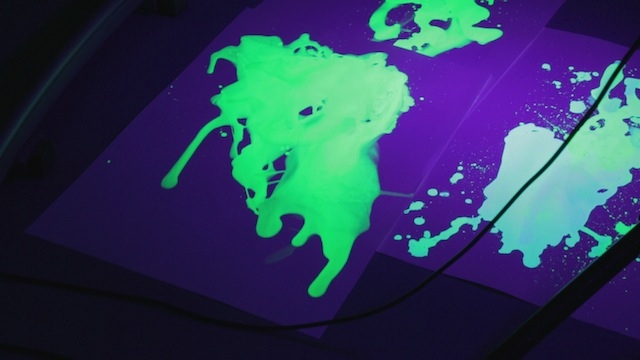There is no lack of traumatic events, big and small, in the world. Both today and through history. Thirty-one people killed in the recent Brussels bombings and yesterday 60 casualties in a Lahore park, most of them women and children. Not to speak of the innumerable cases – most of them likely to cause various kinds of posttraumatic stress – that never reach the headlines.
Coming across Korean artist Jeamin Cha’s videos in Seoul while conducting research for my upcoming Gwangju Biennale, I encounter posttraumatic stress disorder in art too; a hysteria, to be precise. In two related videos, the artist’s confident filmic language reveals men who experience violence – both physical and psychological. Hysterics (2014) is a formally tight seven-minute video made using one shot of a camera circling a room full of tripods, cables and large sheets of paper. Black light reveals spots and blotches on the papers that become all violet and green under this light. A man is lying, seemingly lifeless, on the floor, and as the light goes white and cello music starts playing, we see his body being dragged out of the frame. Suddenly a glittery pom-pom is softly hitting a mirror while a high-pitched female voice is singing in English. The image turns black and the sound of a fire is accompanied by a bell ringing. The video is inspired by Heinrich Heine’s poem ‘The Vale of Tears’, in which a despairing poor couple commit suicide, which for Cha is a way of questioning conditions of life. And questioning in and of itself tends to lead to hysteria, according to her.
The other film, Autodidact (2014), is more straightforward, based on the story of Youngchun Hur, a father who lost his son in 1984 when the latter was doing his military service in the demilitarised zone between North and South Korea. Having taught himself forensic techniques, the father discovered that his son could not have committed suicide (as the military had claimed) but had been shot by someone else. In the video, closeups of Korean handwriting are coupled with a male voiceover that describes Hur’s persistent process but also talks about his thoughts on politics and life.
Although ‘hysteria’ is no longer deployed in clinical diagnoses of posttraumatic stress disorders, it still has a lure. Essentially describing emotional excess that is out of control, it has been historically connected with women: etymologically rooted in the word hystera, ‘womb’ in Ancient Greek, the condition was thought, by the Ancient Greeks (and, by some, even into the Early Modern era), to be caused by the womb ‘wandering’ within the female body; pregnancy was often described as a ‘cure’. The nineteenth-century French neurologist Jean-Marie Charcot advanced the understanding of hysteria as a psychological disorder, while Sigmund Freud removed the Frenchman’s insistence on a hereditary streak. But whereas for Freud, hysteria was an unconscious defence against mental stress or trauma, both he and Charcot continued to see hysteria as a strictly female condition.
Looking at Cha’s videos on Vimeo, I recall artworks made during the 1990s that featured male hysterics: often either paralysed or trapped in meaningless activities. In Douglas Gordon’s video installation 10ms-1 (1994), the literal appearance of male hysteria was found in First World War footage of shellshocked soldiers who cannot stand up, an inability emphasised by the artist having looped the grainy black-and-white film snippet so as to render the task truly Sisyphean. Paul McCarthy’s characters Bossy Burger and Painter featured in separate videoworks (Bossy Burger, 1991; Painter, 1995) but shared a more figurative hysteria in the form of obsessive activities, including mega-messy and incessant cooking and painting.
A couple of decades later, however, the men in Cha’s videos are different. They are motionless and composed. Whereas in Hysterics the hysteria is abstracted, Hur, for example, is determined to find out what happened to his son, giving up his job to concentrate on this self-imposed task. He uses his hysteria to become an agent with a cause, and someone with the ability to help change the course of things. Realising that I am not aware of any ‘female hysterics’ in recent art, I am wondering if hysteria has ‘wandered’ to men. And if so, why?
This article first appeared in the May 2016 issue of ArtReview.
